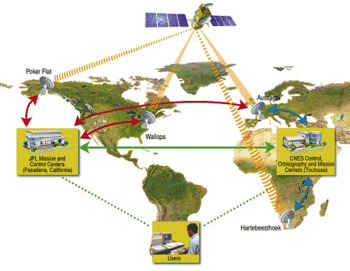The ground segment
The Jason-1 ground segment is made up of three components providing the human (teams) and equipment resources required to ensure the mission's success:
- The Proteus Generic Ground Segment (PGGS, based in Toulouse, France)
- The Project Operation Control Center (POCC, based in Pasadena, California, USA)
- The Ssalto multimission ground segment (based in Toulouse, France).
Mission operations
This comprises the Proteus Generic Ground Segment (PGGS) located in Toulouse, France, the Project Operations Control Center (POCC) located in Pasadena, Ca, USA and the CCI (Instrument Control Center) also located in Toulouse, France.
PGGS
The Proteus Generic Ground Segment provides the necessary capability for operating a Proteus spacecraft. It includes an Earth terminal, a command and control centre and a data communications network. Proteus adapted its facilities to meet Jason-1's requirements. It was used to perform satellite operations during the early phase of the mission (launch, station acquisition, in-orbit acceptance) and then performed spacecraft analysis and navigation functions when the POCC took over routine satellite operations. The PGGS is broken down into three main components: the TTCET Earth terminal, the command control centre (CCC) and the data communications network (DCN). Development of the generic product and the specific adaptation to the Jason-1 mission were managed by the same team.
POCC
The POCC provided the capability for operating Jason-1 during its routine phase, including 1) real-time telemetry and command (JTCC), 2) sequence generation (JSEQ), 3) Earth terminal (ET), 4) science processing and distribution (JSDS), and 5) data archiving (Po.Daac) functions. It was derived from the Topex/Poseidon POCC and simultaneously supported Topex/Poseidon and Jason-1.
Ssalto
The Ssalto multimission ground segment (Segment Sol multimissions d'ALTimétrie, d'Orbitographie et de localisation précise) encompasses ground support facilities for controlling the Doris and Poseidon instruments, processing data from DORIS and the altimeters onboard Topex/Poseidon, Jason-1 and Envisat-1, and providing user services and expert altimetry support.
Ssalto was designed by Cnes, the French space agency, in partnership with its subsidiary CLS and local French industry. Ssalto serves as a common ground segment for the Doris/Spot, Doris/Envisat, Topex/Poseidon, Jason-1 and Envisat missions. It thus responds to a growing commonality of user needs and supports the continued operation of Doris instruments and altimetry payloads flying simultaneously on different satellites.
Ssalto encompasses the resources for:
- controlling onboard Doris and Poseidon instruments, and the Doris orbitography beacon network (CCI)
- obtaining precision orbits (POD)
- processing altimeter and radiometer data (CMA)
- providing user services, and archiving and managing data (Aviso)
The CMA (Multi-mission Altimetry Centre) processes altimetry data from Jason-1 and Envisat, and from Ssalto components that control the instruments (CCI) and determine precise orbits. Other components process Topex/Poseidon and Doris data from other satellites (Spot, Envisat) and distribute data (Aviso).
S. Coutin-Faye et al., 2000: SSALTO: a new ground segment for a new generation of altimetry satellites, Aviso Newsletter, n°7 January 2000.





